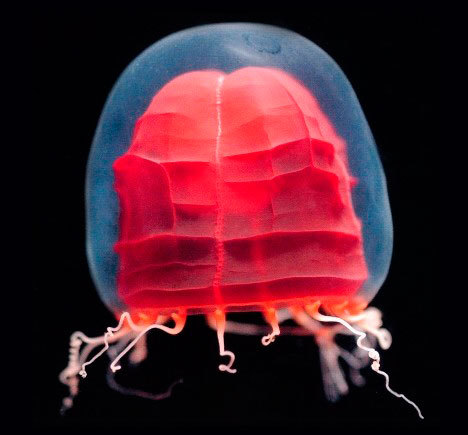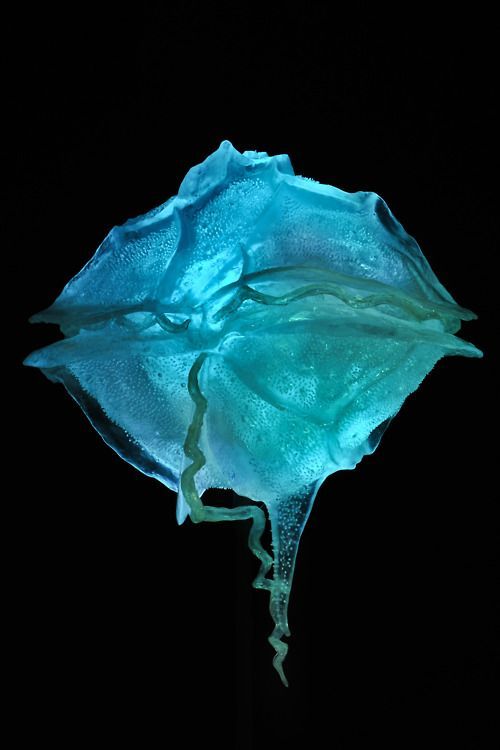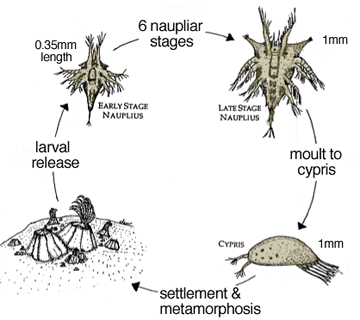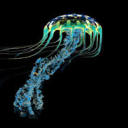Cockatoo Squid


Cockatoo Squid
Galiteuthis phyllura
The Cockatoo squid is a highly-specialized oddity of the deep ocean and found at depths between 300 to 1400 m. It is completely transparent, except for its eyes. It also has bioluminescent photophores that are directed downward: this makes it difficult for deep sea predators to see the Cockatoo Squid. It was named after the Cockatoo because it holds its tentacles above its head, resembling the bird. The Cockatoo squid can also get fairly large with adults reaching lengths of 2.7 meters (over 6 ft.)
Photocredit: https://www.americanscientist.org/article/at-home-in-the-dark
https://www.pinterest.com/pin/28710516347382519/
More Posts from Bioluminescentoceangoddess and Others

Crystal Jellyfish
Aequorea victoria
The Crystal Jellyfish is a graceful, transparent jellyfish with long, thin tentacles. It has bioluminescent organs around it bell that produce a bright, green light. It tends to consume small copepods, but it has the ability to swallow other jellyfish half its size. Furthermore, this jelly is used in biological experiments to detect calcium.
Photo credit: https://www.montereybayaquarium.org/animals/animals-a-to-z/crystal-jelly
https://fineartamerica.com/featured/5-aequorea-crystal-jellyfish-with-amphipods-alexander-semenovscience-photo-library.html


Red Paper Lantern Medusa
Pandea rubra
The Red Paper Lantern resembles a floating, Japanese paper lantern in the deep sea. It has the ability to crumple and wrinkle its bright, red bell, and it is located at depths between 550m to 1200m. It has also been nicknamed the “origami jelly.”
Photo credit: https://commons.wikimedia.org/wiki/Category:Pandea_rubra
http://www.thegorgeousdaily.com/pandea-rubra/



Black Dragonfish
Idiacanthus atlanticus
The Black Dragonfish are needle-like fish that migrate between 500m and 2000m in the deep ocean. Females are black with 6 stripes and lack a barbel, pelvic fins, and sharp teeth. Males, on the other hand, are dark brown and have a barbel, which is the light producing structure on its chin. Furthermore, it uses bioluminescence to detect prey instead of lure prey.
Photo credit: https://scitechdaily.com/scientists-learn-secrets-from-ultra-black-skin-that-allows-deep-sea-fish-to-lurk-unseen/
https://steemit.com/life/@munnashah/the-most-terrible-and-surprising-7-animals-of-the-sea
https://knowyourmeme.com/photos/995601-thalassophobia


Pyrodinium bahamense
Pyrodinium bahamense is a tropical species of dinoflagellates that is found primarily in Atlantic Ocean waters. It prefers salinity around 20 psu and blooms when there are large amounts of nitrogen in the water. The dinoflagellate glows bright blue when agitated by motion. Furthermore, even though this plankton species is beautiful to look at, it causes seafood toxicity.
Photo credit: https://alchetron.com/Pyrodinium-bahamense
https://wonderchews.com/bodies-of-light/

Pram Bug
Phronima sedentaria
The Pram Bug is a deep sea amphipod that is located between 200 to 1000m in the ocean. It has a translucent exoskeleton and can see primarily blue light. It is also is contained in a hollowed out barrel that is used for protection and to house babies. The image above is a female pram bug carrying its young.
Photo Credit:https://ocean.si.edu/ocean-life/invertebrates/phronima-female-and-young

Black- eyed squid
Gonatus onyx
The Black-eyed Squid is roughly over one foot (35 am) and is found at depths as deep as 2500m. The female Black-eyed Squid works fiercely to protect her babies, by carrying around a patch of egg for six to nine months. When the eggs hatch, 2000 to 3000 babies are released into the ocean. However, this makes her vulnerable to predators.
Photocredit: http://tolweb.org/Gonatus+onyx/19769
If you are interested in learning about different types of plankton in the ocean, please check out @planktonqueen page. I post a lot of cool species, photos, and facts.


Barnacle Larvae
Amphibalanus eburneus
When we think of barnacles, we think of the hard, white crustaceans that grow on the side of boats and docks. However, barnacles go through a variety life stages and metamorphosis before they spend their life on a hard surface. The image above is a barnacle larvae when it is in the cypris stage, think of it as a baby barnacle. This larvae is an example of zooplankton and spends a short period of time floating around in the water column. The second image summarizes the life cycle of a barnacle.
Photo source: https://www.nyharbornature.com/blog/barnacles-are-reproducing
https://www.pinterest.com/pin/453174781229895797/


Lav Polyp
leuckartiara octona
The Lav Polypo is a jelly that comes in a variety of colors and shapes; it dwells about 200m in the deep ocean. The red mass inside its translucent bell is the jelly’s reproductive organs. Furthermore, it uses its dull, yellow tentacles can catch unsuspecting prey.
Photo credit: https://www.pinterest.com/pin/65935582019848580/
https://www.petjellyfish.co.uk/shop/live-jellyfish/leuckartiara-octona


Gulper Eel
Saccopharynx sp.
The Gulper Eel is known for its massive jaws, which are capable of swallowing prey whole. It’s stomach is also able to expand twice its size. It is found only in the deep see about 2000 to 3000 meters in depth.
Photo credit: https://www.youtube.com/watch?v=XRO0IjSoHGA
https://marinebiochemistrygc2018.weebly.com/deep-sea-adaptations


Cigar Comb Jelly
beroe forskalii
The Cigar Comb Jelly is a gelatinous ctenophore that is marveled by many due to its sparkling bioluminescence. It tends to elegantly float around 120 m in the ocean. It uses unique, hair-like structures called ctens to move horizontally in the ocean. It also swims in a spiral pattern before consuming zooplankton in the ocean.
Photo credit: https://www.wrobelphoto.com/gelatinouszooplankton/h25347306
https://www.flickr.com/photos/a_migotto/27227530815
-
 mycellpics liked this · 1 year ago
mycellpics liked this · 1 year ago -
 low-level--00 reblogged this · 2 years ago
low-level--00 reblogged this · 2 years ago -
 low-level--00 liked this · 2 years ago
low-level--00 liked this · 2 years ago -
 rabbitsartcorner liked this · 3 years ago
rabbitsartcorner liked this · 3 years ago -
 darknovalatte liked this · 3 years ago
darknovalatte liked this · 3 years ago -
 astrotracksuitbattalion liked this · 3 years ago
astrotracksuitbattalion liked this · 3 years ago -
 despair-with-walnuts liked this · 3 years ago
despair-with-walnuts liked this · 3 years ago -
 windyboysworld liked this · 3 years ago
windyboysworld liked this · 3 years ago -
 miresgaleth liked this · 3 years ago
miresgaleth liked this · 3 years ago -
 tt-squid reblogged this · 3 years ago
tt-squid reblogged this · 3 years ago -
 creaturedeityendless liked this · 3 years ago
creaturedeityendless liked this · 3 years ago -
 vaguelyexistingcloud liked this · 3 years ago
vaguelyexistingcloud liked this · 3 years ago -
 sweet-sea-monster reblogged this · 3 years ago
sweet-sea-monster reblogged this · 3 years ago -
 deliciously-yeeted liked this · 3 years ago
deliciously-yeeted liked this · 3 years ago -
 ash-the-nekogirl reblogged this · 3 years ago
ash-the-nekogirl reblogged this · 3 years ago -
 ash-the-nekogirl liked this · 3 years ago
ash-the-nekogirl liked this · 3 years ago -
 empathwitchliv reblogged this · 3 years ago
empathwitchliv reblogged this · 3 years ago -
 bellyee liked this · 3 years ago
bellyee liked this · 3 years ago -
 dimens1ons liked this · 4 years ago
dimens1ons liked this · 4 years ago -
 opossum-mossum liked this · 4 years ago
opossum-mossum liked this · 4 years ago -
 that-lesbian-phenotype liked this · 4 years ago
that-lesbian-phenotype liked this · 4 years ago -
 fishwantmewomenfearme reblogged this · 4 years ago
fishwantmewomenfearme reblogged this · 4 years ago -
 fishwantmewomenfearme liked this · 4 years ago
fishwantmewomenfearme liked this · 4 years ago -
 relatablepicturesoftinywhalesfin liked this · 4 years ago
relatablepicturesoftinywhalesfin liked this · 4 years ago -
 senoritafish liked this · 4 years ago
senoritafish liked this · 4 years ago -
 velociraptrix reblogged this · 4 years ago
velociraptrix reblogged this · 4 years ago -
 velociraptrix liked this · 4 years ago
velociraptrix liked this · 4 years ago -
 starlightbrethren liked this · 4 years ago
starlightbrethren liked this · 4 years ago -
 mloramagica reblogged this · 4 years ago
mloramagica reblogged this · 4 years ago -
 elbiotipo reblogged this · 4 years ago
elbiotipo reblogged this · 4 years ago -
 elbiotipo liked this · 4 years ago
elbiotipo liked this · 4 years ago -
 typhlonectes reblogged this · 4 years ago
typhlonectes reblogged this · 4 years ago -
 typhlonectes liked this · 4 years ago
typhlonectes liked this · 4 years ago -
 soymilkspiders liked this · 4 years ago
soymilkspiders liked this · 4 years ago -
 zebruh reblogged this · 4 years ago
zebruh reblogged this · 4 years ago -
 zebruh liked this · 4 years ago
zebruh liked this · 4 years ago -
 tt-squid reblogged this · 4 years ago
tt-squid reblogged this · 4 years ago -
 disableddeinosaur liked this · 4 years ago
disableddeinosaur liked this · 4 years ago -
 intrepideternal liked this · 4 years ago
intrepideternal liked this · 4 years ago -
 tt-squid liked this · 4 years ago
tt-squid liked this · 4 years ago -
 ailinenelpaisdelasmaravillas liked this · 4 years ago
ailinenelpaisdelasmaravillas liked this · 4 years ago -
 dgm56 liked this · 4 years ago
dgm56 liked this · 4 years ago -
 punkrock-furiosa liked this · 4 years ago
punkrock-furiosa liked this · 4 years ago -
 isac24r liked this · 4 years ago
isac24r liked this · 4 years ago

Bioluminescence is a chemical reaction that produces light. Many deep sea animals use bioluminescence. This blog is dedicated to educating the public about the amazing creatures that thrive in the deep sea.
57 posts